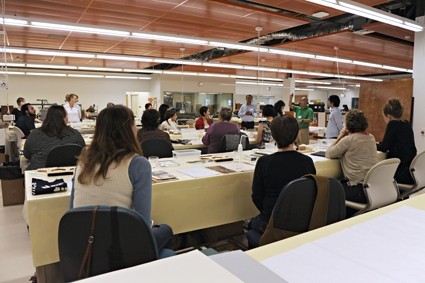Introduction to Japanese Paper Conservation Workshop, 27 August 2012
By JOL Admin | 9 October 2012

State Library of Queensland was honoured to have three conservators from the National Archives of Japan (NAJ) running a one day workshop on the traditional methods of Japanese paper conservation. These conservators came with a wealth of knowledge with one of the conservators having 35 years of experience. The workshop was held in the conservation lab on Monday 27 August 2012. The workshop was designed specifically for paper conservators. The topics for the workshop were
- Introduction to Japanese paper conservation: Tools and materials
- Tsukuroi: Infill for losses in paper due to insect damage with Japanese tissue paper
- Urauchi: Lining fragile works with Japanese tissue paper to give strength
- Yotsume-toji: Japanese basic four-hole binding
- Disaster recovery of material affected by 2011 tsunami
The workshop started with the introduction of tools and materials used in Japanese conservation. This topic covered Washi-Japanese hand made papers, its fibres and different thicknesses for different purposes in conservation. Also covered was the cooking and use of wheat starch as an adhesive.
The first hands-on exercise was on the infill of the losses caused by insect damage.
Thin Japanese tissue paper was used to fill in the losses with starch paste as an adhesive. A few different methods of lining both traditional and non-traditional were demonstrated. Lining is a process where a thin Japanese tissue paper is attached at the back of the fragile work to give strength and stability. The last exercise was on four hole Japanese book binding technique. The Instructors also demonstrated different methods used in salvaging materials which were affected by the 2011 tsunami.
The workshop was quite informative with participants learning both traditional and non-traditional ways of conserving works on paper. It was a hands-on workshop and participants were given an opportunity to practice what was being taught. The response from the participants was very positive and everyone was happy to learn so many techniques in a short period of time which expanded participants repertoire of paper conservation.
Gajendra Rawat - Acting Senior Conservator, State Library of Queensland
Comments
Your email address will not be published.
We welcome relevant, respectful comments.